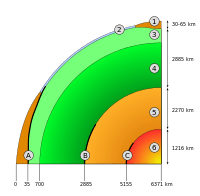Astrognosy
Astrognosy deals with the materials of celestial objects and their general exterior and interior constitution. It is a technical term in English.[1]
Generally, the performance of radiation astronomy yields facts about those portions of celestial objects such as the Sun or the Earth that are radiating at least in the direction of the telescopes and detectors where the observer is at.
But, what about the constitution of any celestial object with depth away from the radiating surface or near-surface region?
Sun
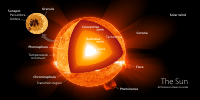
On the right is a model for the internal structure of the Sun.
Mercury
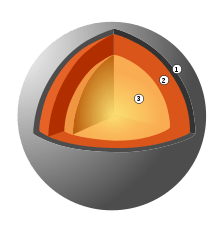
A theory for the internal structure of Mercury is shown on the right, where
- Crust - 100-200 km thick,
- Mantle - 600 km thick, and
- Nucleus - 1,800 km radius.
Venus
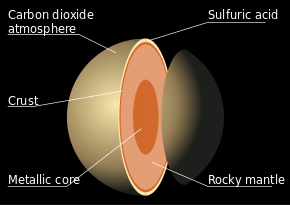
On the right is a model for the interior structure of Venus.
Earth
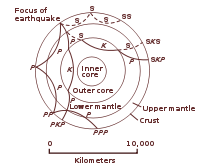
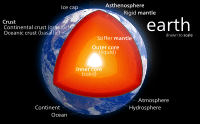
"Evidence from geoseismology, heat flow at the surface, and mineral physics is combined with the Earth's mass and moment of inertia to infer models of the Earth's interior - its composition, density, temperature, pressure. For example, the Earth's mean specific gravity (5.515) is far higher than the typical specific gravity of rocks at the surface (2.7–3.3), implying that the deeper material is denser. This is also implied by its low moment of inertia (0.33 M R2, compared to 0.4 M R2 for a sphere of constant density). However, some of the density increase is compression under the enormous pressures inside the Earth. The effect of pressure can be calculated using the Adams–Williamson equation. The conclusion is that pressure alone cannot account for the increase in density."[2]
"Reconstruction of seismic reflections in the deep interior indicate some major discontinuities in seismic velocities that demarcate the major zones of the Earth: inner core, outer core, mantle, lithosphere and crust."[2]
"The seismic model of the Earth does not by itself determine the composition of the layers. For a complete model of the Earth, mineral physics is needed to interpret seismic velocities in terms of composition. The mineral properties are temperature-dependent, so the geotherm must also be determined. This requires physical theory for thermal conduction and convection and the heat contribution of [radionuclides] radioactive elements. The main model for the radial structure of the interior of the Earth is the Preliminary Reference Earth Model (PREM). Some parts of this model have been updated by recent findings in mineral physics (see post-perovskite) and supplemented by seismic tomography."[2]
Crusts
Lithospheres
"Between the crust and the mantle is the Mohorovičić discontinuity.[3]"[2]
Mantles
"The mantle is mainly composed of silicates, and the boundaries between layers of the mantle are consistent with phase transitions.[4]"[2]
"The mantle acts as a solid for seismic waves, but under high pressures and temperatures it deforms so that over millions of years it acts like a liquid. This makes plate tectonics possible. Geodynamics is the study of the fluid flow in the mantle and core."[2]
"The mantle itself is divided into the upper mantle, transition zone, lower mantle and D′′ layer."[2]
Outer cores
"Reconstructions of seismic waves in the deep interior of the Earth show that there are no S-waves in the outer core. This indicates that the outer core is liquid, because liquids cannot support shear. The outer core is liquid, and the motion of this highly conductive fluid generates the Earth's field (see geodynamo)."[2]
Inner cores
"[W]e know that the Earth's core is composed of an alloy of iron and other minerals.[4]"[2]
"A PKJKP [P wave, traversing the outer core K, and the inner core J, to emerge again as the P wave] traverses the inner core as a shear wave, so this is the direct evidence that the inner core is solid, because only in the solid material the shear wave can exist. In the liquid material, say water, only the compressional wave can travel through."[5]
Studying "archived data from about 20 large earthquakes, all monitored by an array of German seismic detectors back in the 1980s and '90s" has "reliably detected" a PKJKP wave in 2005, demonstrating that the inner core is solid.[6]
"The inner core, however, is solid because of the enormous pressure.[3]"[2]
The inner core "is a solid ball of superhot iron and nickel alloy about 760 miles (1,220 kilometers) in diameter. ... the inner core is, at 10,800 degrees Fahrenheit (6,000 degrees Celsius), as hot as the surface of the sun."[7]
"We know the Earth's inner core is composed mostly of iron".[8]
"The metal [iron] was subjected to more than 200 billion pascals of pressure".[7]
"[M]aterial within Earth's inner core is apparently distributed in a lopsided way ... The weakness of iron might lead crystallites in the inner core to flow and line up a certain way".[7]
"[T]he speed at which the inner core spun apparently fluctuated over the course of approximately decades between 1961 and 2007."[7]
"As the inner core cools, crystallizing iron releases impurities, sending lighter molten material into the liquid outer core. This upwelling, combined with the Earth's rotation, drives convection, forcing the molten metal into whirling vortices. These vortices stretch and twist magnetic field lines, creating Earth’s magnetic field. Currently, the center of the field, called an axis, emerges in the Arctic Ocean west of Ellesmere Island, about 300 miles (500 kilometers) from the geographic North Pole."[9]
"In the last decade, seismic waves from earthquakes revealed the inner core looks like a navel orange, bulging slightly more on its western half. Geoscientists recently explained the asymmetry by proposing a convective loop: The inner core might be crystallizing on one half and melting on the other."[9]
"The lopsided growth of the inner core makes convection in the outer core a little bit lopsided, and that then induces the geomagnetic field to have this lopsided or eccentric character too".[10]
"Magnetic particles trapped and aligned in rocks reveal that the magnetic north pole wandered around the Western Hemisphere over the past 10,000 years, and circled the Eastern Hemisphere before that — a result mirrored by the numerical test."[9]
"The key question for interesting ideas like translational instability is, 'Can we test it?' ... What we're doing is proposing a test, and we think it's a good test because people can go out and look for eccentricity in the rock record and that will either confirm or shoot down this idea."[10]
"Within less than 100 million years, everything that has been crystallized on the west will have melted on the east"[11]
Seismic "waves appear to travel faster through the inner core from north to south than from west to east. Seismic properties also seemed to vary between the Eastern and Western hemispheres of the globe."[12]
There is a "124-mile (200-km) thick layer of dense material detected on its surface."[12]
"[T]he inner core [may be] shifted slightly off-center, just to the east. This would put more pressure on the western side, where it would be closer to the center of the planet, and less pressure on the eastern side. The result could be a perpetually denser Western hemisphere and a continual flow of dense fluid from the east that eventually spreads out atop the entire inner core."[12]
"The inner core is basically regenerating itself. And superimposed on that is this overall cooling that makes the inner core bigger and bigger over time".[13]
"It is the first observational evidence that the inner core rotates at a variety of speeds with respect to the mantle...It also reconciles old discrepancies".[14]
"The inner core, on average, rotates eastward. At the speeds it travels, it might, on average, complete a revolution every 750 to 1,440 years. However, these speeds appear unstable, which makes it uncertain just how long it actually takes to finish a turn on its axis".[7]
Moon
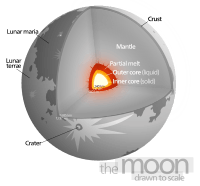
The internal structure of the Moon is modeled on the right and includes a core, mantle and crust.
Mars

"This artist's concept of the interior of Mars [on the right] shows a hot liquid core that is about one-half the radius of the planet. The core is mostly made of iron with some possible lighter elements such as sulfur. The mantle is the darker material between the core and the thin crust."[15]
"Mars has not cooled to a completely solid iron core, rather its interior is made up of either a completely liquid iron core or a liquid outer core with a solid inner core."[15]
"Earth has an outer liquid iron core and solid inner core. This may be the case for Mars as well."[15]
"Mars is influenced by the gravitational pull of the Sun. This causes a solid body tide with a bulge toward and away from the Sun (similar in concept to the tides on Earth). However, for Mars this bulge is much smaller, less than 1 centimeter (0.4 inch). By measuring this bulge in the Mars gravity field we can determine how flexible Mars is. The size of the measured tide is large enough to indicate the core of Mars can not be solid iron but must be at least partially liquid."[15]
"The tidal bulge is a very small but detectable force on the spacecraft. It causes a drift in the tilt of the spacecraft's orbit around Mars of one-thousandth of a degree over a month."[16]
"The precession is the slow motion of the spin pole of Mars as it moves along a cone in space (similar to a spinning top). For Mars, it takes 170,000 years to complete one revolution. The precession rate indicates how much the mass of Mars is concentrated toward the center. A faster precession rate indicates a larger dense core, compared to a slower precession rate."[15]
"Our results indicate the mass change for the southern carbon dioxide ice cap is 30 to 40 percent larger than the northern ice cap, which agrees well with the predictions of the global atmosphere models of Mars."[15]
"The amount of total mass change depends on assumptions about the shape of the sublimated portion of the cap. The largest mass exchange occurs if we assume the cap change is uniform or flat over the entire cap, while the lowest mass exchange corresponds to a conically shaped cap change."[15]
Ceres
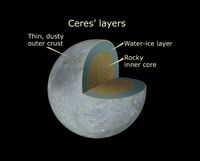
"Observations of 1 Ceres, the largest known asteroid, have revealed that the object may be a "mini planet," and may contain large amounts of pure water ice beneath its surface."[17]
"The observations by NASA's Hubble Space Telescope also show that Ceres shares characteristics of the rocky, terrestrial planets like Earth. Ceres' shape is almost round like Earth's, suggesting that the asteroid may have a "differentiated interior," with a rocky inner core and a thin, dusty outer crust."[17]
"Ceres is an embryonic planet."[17]
"Gravitational perturbations from Jupiter billions of years ago prevented Ceres from accreting more material to become a full-fledged planet."[17]
"Hubble snapped 267 images of Ceres. From those snapshots, the astronomers determined that the asteroid has a nearly round body. The diameter at its equator is wider than at its poles. Computer models show that a nearly round object like Ceres has a differentiated interior, with denser material at the core and lighter minerals near the surface. All terrestrial planets have differentiated interiors. Asteroids much smaller than Ceres have not been found to have such interiors."[17]
Jupiter
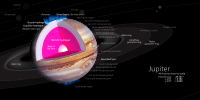
The model for the interior of Jupiter suggests the occurrence of such materials as metallic hydrogen.
Callisto
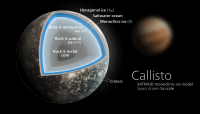
The theoretical internal structure model for Callisto on the right includes rock, monoclinic ice, tetragonal ice, hexagonal ice, and cubic ice.
Europa
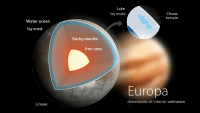
On the right is a model for the internal structure of Europa.
Ganymede
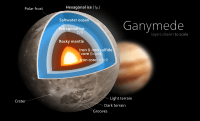
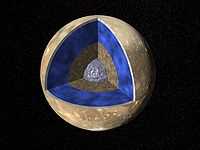
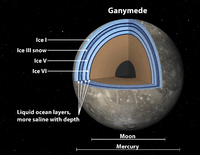
A variety of models have been suggested for the interior constitution of Ganymede. The first diagram at the right suggests ice, water, and an iron-based core.
The first image at the left suggests another interior: "The cut-out reveals the interior structure of this icy moon. This structure consists of four layers based on measurements of Ganymede's gravity field and theoretical analyses using Ganymede's known mass, size and density. Ganymede's surface is rich in water ice and Voyager and Galileo images show features which are evidence of geological and tectonic disruption of the surface in the past. As with the Earth, these geological features reflect forces and processes deep within Ganymede's interior. Based on geochemical and geophysical models, scientists expected Ganymede's interior to either consist of: a) an undifferentiated mixture of rock and ice or b) a differentiated structure with a large lunar sized "core" of rock and possibly iron overlain by a deep layer of warm soft ice capped by a thin cold rigid ice crust. Galileo's measurement of Ganymede's gravity field during its first and second encounters with the huge moon have basically confirmed the differentiated model and allowed scientists to estimate the size of these layers more accurately. In addition the data strongly suggest that a dense metallic core exists at the center of the rock core. This metallic core suggests a greater degree of heating at sometime in Ganymede's past than had been proposed before and may be the source of Ganymede's magnetic field discovered by Galileo's space physics experiments."[18]
The second image at the right suggests a variety of pressure-related ices similar to the model directly above it.
This "new model, based on experiments in the laboratory that simulate salty seas, shows that the ocean and ice may be stacked up in multiple layers, more like a club sandwich."[19]
"Ice comes in different forms depending on pressures. "Ice I," the least dense form of ice, is what floats in your chilled beverages. As pressures increase, ice molecules become more tightly packed and thus more dense. Because Ganymede's oceans are up to 500 miles (800 kilometers) deep, they would experience more pressure than Earth's oceans. The deepest and most dense form of ice thought to exist on Ganymede is called "Ice VI." [...] With enough salt, liquid in Ganymede can become dense enough to sink to the very bottom of the seafloor, below Ice VI. [...] What's more, the model shows that a strange phenomenon might occur in the uppermost liquid layer, where ice floats upward. In this scenario, cold plumes cause Ice III to form. As the ice forms, salt precipitates out. The salt then sinks down while the ice "snows" upward. Eventually, this ice would melt, resulting in a slushy layer in Ganymede's club sandwich structure."[19]
Io
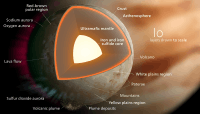
A model for the internal structure of Io shown on the right includes an ultramafic mantle and an iron and iron sulfide core.
Saturn
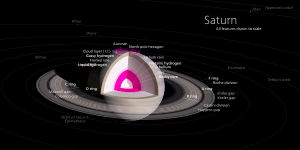
The internal structure of the gaseous giant Saturn is modeled on the right.
Titan
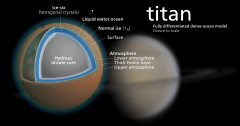
The internal structure of Titan is modeled on the right according to the fully differentiated dense-ocean model.
Uranus
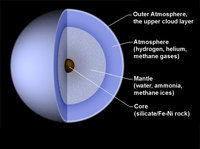
Uranus has a core and a mantle as shown in the model on the right.
Neptune
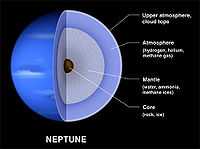
"The atmosphere of Neptune, similar to Uranus, consists of mainly hydrogen, methane, and helium. Below it is a liquid hydrogen layer including helium and methane. The lower layer is liquid hydrogen compounds, oxygen, and nitrogen. It is believed that the planet core comprises rock and ice. Average density, as well as the greatest proportion of core per planet size, is the greatest among the gaseous planets."[20]
Original research
- See also: Original research inquiry and Research
Hypotheses:
- The cores of each astronomical spheroidal object in orbit around the Sun has a systematically higher positive charge than the surface of the object.
- See also: Control groups, Proof of concept, and Proof of technology
See also
References
- ↑ Douglas O. Gough (October 1996). "Astereoasteroseismology". The Observatory 116 (10): 313-5.
- 1 2 3 4 5 6 7 8 9 10 "Geophysics, In: Wikipedia". San Francisco, California: Wikimedia Foundation, Inc. October 18, 2012. Retrieved 2012-11-16.
- 1 2 Lowrie, William (2004). Fundamentals of Geophysics. Cambridge University Press. ISBN 0-521-46164-2.
- 1 2 Jean-Paul Poirier (2000). Introduction to the Physics of the Earth's Interior. Cambridge Topics in Mineral Physics & Chemistry. Cambridge University Press. ISBN 0-521-66313-X.
- ↑ Aimin Cao (April 14, 2005). "Finally, a Solid Look at Earth's Core". Live Science. Retrieved 2013-05-14.
- ↑ Robert Roy Britt (April 14, 2005). "Finally, a Solid Look at Earth's Core". Live Science. Retrieved 2013-05-14.
- 1 2 3 4 5 Charles Q. Choi (May 13, 2013). "Earth's Rotating Inner Core Shifts Its Speed". Yahoo! News. Retrieved 2013-05-14.
- ↑ Arianna Gleason (May 13, 2013). "Earth's Rotating Inner Core Shifts Its Speed". Yahoo! News. Retrieved 2013-05-14.
- 1 2 3 Becky Oskin (July 18, 2012). "Why Earth's Magnetic Field Is Wonky". LiveScience. Retrieved 2013-05-14.
- 1 2 Peter Olson (July 18, 2012). "Why Earth's Magnetic Field Is Wonky". LiveScience. Retrieved 2013-05-14.
- ↑ Thierry Alboussiere (August 4, 2010). "Earth's Inner Core Might Be on the Move". Live Science. Retrieved 2013-05-14.
- 1 2 3 Lynne Peeples (August 4, 2010). "Earth's Inner Core Might Be on the Move". Live Science. Retrieved 2013-05-14.
- ↑ Michael Bergman (August 4, 2010). "Earth's Inner Core Might Be on the Move". Live Science. Retrieved 2013-05-14.
- ↑ Hrvoje Tkalcic (May 13, 2013). "Earth's Rotating Inner Core Shifts Its Speed". Yahoo! News. Retrieved 2013-05-14.
- 1 2 3 4 5 6 7 Charles Yoder (6 March 2003). "Scientists Say Mars Has a Liquid Iron Core". Pasadena, California USA: NASA/JPL. Retrieved 2015-02-04.
- ↑ Alex Konopliv (6 March 2003). "Scientists Say Mars Has a Liquid Iron Core". Pasadena, California USA: NASA/JPL. Retrieved 2015-02-04.
- 1 2 3 4 5 Lucy A. McFadden (7 September 2005). "Largest Asteroid May Be 'Mini Planet' with Water Ice". Baltimore, Maryland USA: HubbleSite. Retrieved 2015-02-04.
- ↑ Sue Lavoie (December 16, 1997). "PIA00519: Ganymede G1 & G2 Encounters - Interior of Ganymede". Pasadena, California USA: NASA/JPL. Retrieved 2014-06-11.
- 1 2 Jon Nelson (May 01, 2014). "Possible 'Moonwich' of Ice and Oceans on Ganymede (Artist's Concept)". Pasadena, California USA: NASA/JPL. Retrieved 2014-06-11.
- ↑ Autumn Burdick (20 January 2011). "Neptune's Interior". Washington, DC USA: NASA. Retrieved 2015-02-04.
External links
- African Journals Online
- Bing Advanced search
- Google Books
- Google scholar Advanced Scholar Search
- International Astronomical Union
- JSTOR
- Lycos search
- NASA/IPAC Extragalactic Database - NED
- NASA's National Space Science Data Center
- Office of Scientific & Technical Information
- Questia - The Online Library of Books and Journals
- SAGE journals online
- The SAO/NASA Astrophysics Data System
- Scirus for scientific information only advanced search
- SDSS Quick Look tool: SkyServer
- SIMBAD Astronomical Database
- SIMBAD Web interface, Harvard alternate
- Spacecraft Query at NASA.
- SpringerLink
- Taylor & Francis Online
- Universal coordinate converter
- Wiley Online Library Advanced Search
- Yahoo Advanced Web Search
| |||||||||||||||||||||||||||||||||||
| |||||||||||||||||||||||||||||||||||
| |||||||||||||||||||||||||||||||||||||||||
![]() This is a research project at http://en.wikiversity.org
This is a research project at http://en.wikiversity.org
| |
Educational level: this is a research resource. |
| |
Resource type: this resource is an article. |
| |
Resource type: this resource contains a lecture or lecture notes. |
| |
Subject classification: this is an astronomy resource. |
| |
Subject classification: this is an astrophysics resource. |
| |
Subject classification: this is a Geology resource. |
